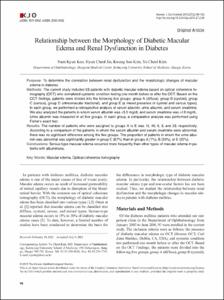Relationship between the Morphology of Diabetic Macular Edema and Renal Dysfunction in Diabetes
- Keimyung Author(s)
- Kim, Kwang Soo; Kim, Yu Cheol
- Department
- Dept. of Ophthalmology (안과학)
- Journal Title
- Korean Journal of Ophthalmology
- Issued Date
- 2013
- Volume
- 27
- Issue
- 2
- Abstract
- Purpose: To determine the correlation between renal dysfunction and the morphologic changes of macular edema in diabetes. Methods: The current study included 93 patients with diabetic macular edema based on optical coherence tomography (OCT) who completed systemic condition testing one month before or after the OCT. Based on the OCT findings, patients were divided into the following five groups: group A (diffuse), group B (cystoid), group C (serous), group D (vitreomacular tractional), and group E (a mixed presence of cystoid and serous types). In each group, we performed a retrospective analysis of serum albumin, urine albumin, and serum creatinine. We also analyzed the patients in whom serum albumin was <3.0 mg/dL and serum creatinine was >1.6 mg/dL. Urine albumin was measured in all five groups. In each group, a comparative analysis was performed using Fisher’s exact test. Results: The number of patients who were assigned to groups A to E was 15, 46, 6, 3, and 23, respectively. According to a comparison of the patients in whom the serum albumin and serum creatinine were abnormal, there was no significant difference among the five groups. The proportion of patients in whom the urine albumin was abnormal was significantly greater in group C (67%) than in groups A (7%), B (20%), or E (22%). Conclusions: Serous-type macular edema occurred more frequently than other types of macular edema in patients with albuminuria.
- Publisher
- School of Medicine
- Citation
- Nam Kyun Koo et al. (2013). Relationship between the Morphology of Diabetic Macular Edema and Renal Dysfunction in Diabetes. Korean Journal of Ophthalmology, 27(2), 98–102. doi: 10.3341/kjo.2013.27.2.98
- Type
- Article
- ISSN
- 1011-8942
- Appears in Collections:
- 1. School of Medicine (의과대학) > Dept. of Ophthalmology (안과학)
- 파일 목록
-
-
Download
 oak-aaa-03468.pdf
기타 데이터 / 7.3 MB / Adobe PDF
oak-aaa-03468.pdf
기타 데이터 / 7.3 MB / Adobe PDF
-
Items in Repository are protected by copyright, with all rights reserved, unless otherwise indicated.